Environmental Factors Affecting Freshwater Snail Intermediate Hosts in Shenzhen and Adjacent Region, South China
Abstract
1. Introduction
2. Materials and Methods
2.1. Study Area
2.2. Malacological Surveys
2.3. Local Environmental Variables
2.4. Predator and Competitor Survey
2.5. Human Disturbance
2.6. Data Analysis
2.6.1. Classification and Regression Tree (CART)
2.6.2. Canonical Correspondence Analysis (CCA)
3. Results
3.1. Environmental Conditions
3.2. Occurrence and Abundance of Freshwater Snails
3.3. CART Analysis
3.3.1. Variables of Importance
3.3.2. Model Performance Evaluation
3.4. CCA Analysis
4. Discussion
5. Conclusions
Supplementary Materials
Author Contributions
Funding
Institutional Review Board Statement
Informed Consent Statement
Data Availability Statement
Conflicts of Interest
References
- Strong, E.E.; Gargominy, O.; Ponder, W.F.; Bouchet, P. Global diversity of gastropods (Gastropoda; Mollusca) in freshwater. In Freshwater Animal Diversity Assessment; Developments in Hydrobiology; Balian, E.V., Lévêque, C., Segers, H., Martens, K., Eds.; Springer: Dordrecht, The Netherlands, 2007; Volume 198, pp. 149–166. [Google Scholar]
- Soldánová, M.; Selbach, C.; Kalbe, M.; Kostadinova, A.; Sures, B. Swimmer’s itch: Etiology, impact, and risk factors in Europe. Trends Parasitol. 2013, 29, 65–74. [Google Scholar] [CrossRef]
- Lu, X.T.; Gu, Q.Y.; Limpanont, Y.; Song, L.G.; Wu, Z.D.; Okanurak, K.; Lv, Z.Y. Snail-borne parasitic diseases: An update on global epidemiological distribution, transmission interruption and control methods. Infect. Dis. Poverty 2018, 7, 28. [Google Scholar] [CrossRef]
- Gray, D.J.; McManus, D.P.; Li, Y.; Williams, G.M.; Bergquist, R.; Ross, A.G. Schistosomiasis elimination: Lessons from the past guide the future. Lancet Infect. Dis. 2010, 10, 733–736. [Google Scholar] [CrossRef] [PubMed]
- Wang, M.L.; Liu, B.X. Advances in the characteristics of Schistosomiasis infection and its immunopathological mechanism. J. Microbiol. 2020, 40, 109–113. (In Chinese) [Google Scholar]
- Xu, J.; Li, S.Z.; Zhang, L.J.; Bergquist, R.; Dang, H.; Wang, Q.; Lv, S.; Wang, T.P.; Lin, D.D.; Liu, J.B.; et al. Surveillance-based evidence: Elimination of schistosomiasis as a public health problem in the Peoples’ Republic of China. Infect. Dis. Poverty 2020, 9, 63. [Google Scholar] [CrossRef]
- Barratt, J.; Chan, D.; Sandaradura, I.; Malik, R.; Spielman, D.; Lee, R.; Marriott, D.; Harkness, J.; Ellis, J.; Stark, D. Angiostrongylus cantonensis: A review of its distribution, molecular biology and clinical significance as a human pathogen. Parasitology 2016, 143, 1087–1118. [Google Scholar] [CrossRef] [PubMed]
- Song, L.G.; Wang, X.W.; Yang, Z.; Lv, Z.Y.; Wu, Z.D. Angiostrongylus cantonensis in the vector snails Pomacea canaliculata and Achatina fulica in China: A meta-analysis. Parasitol. Res. 2016, 115, 913–923. [Google Scholar] [CrossRef]
- Liao, Y.; Sun, X.; Wu, Z.D. Advances in pathogenic mechanisms of Angiostrongylus cantonensis infection. Chin. J. Schistosomiasis Control 2019, 31, 98–102. [Google Scholar]
- Puthiyakunnon, S.; Chen, X. Angiostrongylus. In Biology of Foodborne Parasites; Xiao, L., Ryan, U., Feng, Y., Eds.; CRC Press: Boca Raton, FL, USA, 2015; pp. 235–254. [Google Scholar]
- Lv, S.; Zhang, Y.; Liu, H.X.; Hu, L.; Yang, K.; Steinmann, P.; Chen, Z.; Wang, L.Y.; Utzinger, J.; Zhou, X.N. Invasive snails and an emerging infectious disease: Results from the first national survey on Angiostrongylus cantonensis in China. PLoS Negl. Trop. Dis. 2009, 3, e368. [Google Scholar] [CrossRef]
- Deng, Z.H.; Cai, J.S.; Lin, R.X.; Pei, F.Q.; Cui, H.R.; Ou, Y.; Gao, X.X.; Wang, K.; Zhou, S.Q.; Xie, Y.M. The first local outbreak of Angiostrongylus cantonensis infection In Guangdong province. South China J. Prev. Med. 2007, 33, 17–20. (In Chinese) [Google Scholar]
- Lv, S.; Zhang, Y.; Chen, S.R.; Wang, L.B.; Fang, W.; Chen, F.; Jiang, J.Y.; Li, Y.L.; Du, Z.W.; Zhou, X.N. Human angiostrongyliasis outbreak in Dali, China. PLoS Negl. Trop. Dis. 2009, 3, e520. [Google Scholar] [CrossRef] [PubMed]
- Sangwan, A.K.; Jackson, B.; De Glanville, W.; Pfeiffer, D.U.; Stevens, K.B. Spatial analysis and identification of environmental risk factors affecting the distribution of Indoplanorbis and Lymnaea species in semi-arid and irrigated areas of Haryana, India. Parasit. Epidemiol. Control 2016, 1, 252–262. [Google Scholar] [CrossRef] [PubMed]
- Ross, A.G.; Bartley, P.B.; Sleigh, A.C.; Olds, G.R.; Li, Y.; Williams, G.M.; McManus, D.P. Schistosomiasis. N. Engl. J. Med. 2002, 346, 1212–1220. [Google Scholar] [CrossRef] [PubMed]
- Gilioli, G.; Schrader, G.; Carlsson, N.; van Donk, E.; van Leeuwen, C.H.; Martín, P.R.; Pasquali, S.; Vilà, M.; Vos, S. Environmental risk assessment for invasive alien species: A case study of apple snails affecting ecosystem services in Europe. Environ. Impact Assess. Rev. 2017, 65, 1–11. [Google Scholar] [CrossRef]
- Mereta, S.T.; Boets, P.; Bayih, A.A.; Malu, A.; Ephrem, Z.; Sisay, A.; Endale, H.; Yitbarek, M.; Jemal, A.; De Meester, L.; et al. Analysis of environmental factors determining the abundance and diversity of macroinvertebrate taxa in natural wetlands of Southwest Ethiopia. Ecol. Inform. 2012, 7, 52–61. [Google Scholar] [CrossRef]
- WHO. Study Group on the Ecology of Intermediate Snail Hosts of Bilharziasis; WHO Technical Report Series; WHO: Geneva, Switzerland, 1957; p. 120. [Google Scholar]
- Liu, Z.Y.; Zhou, T.T.; Cui, Y.D.; Li, Z.F.; Wang, W.M.; Chen, Y.S.; Xie, Z.C. Environmental filtering and spatial processes equally contributed to macroinvertebrate metacommunity dynamics in the highly urbanized river networks in Shenzhen, South China. Ecol. Process. 2021, 10, 23. [Google Scholar] [CrossRef]
- Gao, S.T.; Li, X.H.; Huang, S.Y.; Xie, X.; Mei, S.J.; Ruan, C.W.; Huang, D.N. Primary investigation of distribution and ecological environment of Biomphalaria straminea in Dasha and Guanlan Rivers in Shenzhen areas. China Trop. Med. 2013, 13, 313–317. (In Chinese) [Google Scholar]
- Li, X.H.; Gao, S.T.; Xie, X.; Mei, S.J.; Huang, D.N.; Huang, S.Y.; Ruan, C.W.; Wang, X.; Chen, D.L. Investigation on distribution and ecology of Biomphalaria straminea in Yan-Tian and Kui-Chong Rivers in Shenzhen. J. Travel Med. 2013, 13, 1276–1278. (In Chinese) [Google Scholar]
- Lu, W.C.; Huang, S.Y.; Zhang, Q.M.; Zhang, Q.L.; Chen, P.H.; Zhang, Y.Q.; Liu, M.R.; Deng, Z.H. Investigation of distribution and ecological environment of Biomphalaria straminea at some rivers in Shenzhen Dongguang and Huizhou area. South China J. Pre. Med. 2017, 43, 277–279. (In Chinese) [Google Scholar]
- Yang, Y.; Huang, S.Y.; Pei, F.Q.; Jiang, Q.W.; Deng, Z.H.; Zhou, Y.B. Spatial distribution and habitat suitability of Biomphalaria straminea, intermediate host of Schistosoma mansoni, in Guangdong, China. Infect. Dis. Poverty 2018, 7, 109. [Google Scholar] [CrossRef]
- Gao, S.T.; Li, X.H.; Zhang, R.L.; Xie, X.; Huang, D.N. Investigation on the infection status of major host snails of Angiostrongylus cantonesis in Nanshan District of Shenzhen City. J. Med. Pest. Control 2016, 32, 866–868. (In Chinese) [Google Scholar]
- Huang, D.N.; Zhang, R.L.; Wu, W.H.; Tang, Y.J.; Li, X.H.; Gao, S.T. Effects of different ecological environment on the distribution of Pomacea canaliculata. J. Trop. Med. 2018, 18, 229–232. (In Chinese) [Google Scholar]
- Shenzhen Climate Bulletin. 2019. Available online: http://weather.sz.gov.cn/xingxigongkai/tongjishuju/shujujiedu/ (accessed on 2 August 2022).
- Ng, C.N.; Xie, Y.J.; Yu, X.J. Measuring the spatio-temporal variation of habitat isolation due to rapid urbanization: A case study of the Shenzhen River crossboundary catchment, China. Landsc. Urban Plan. 2011, 103, 44–54. [Google Scholar] [CrossRef]
- Mohammed, N.; Madsen, H.; Ahmed, A. Types of trematodes infecting freshwater snails found in irrigation canals in the East Nile locality, Khartoum, Sudan. Infect. Dis. Poverty 2016, 5, 16. [Google Scholar] [CrossRef] [PubMed]
- Liu, Y.Y.; Zhang, W.Z.; Wang, Y.X.; Wang, E.Y. Economic Fauna of China (Freshwater Mollusk); Science Press: Beijing, China, 1979; p. 134. (In Chinese) [Google Scholar]
- Habib, M.R.; Lv, S.; Guo, Y.H.; Gu, W.B.; Standley, C.J.; Caldeira, R.L.; Zhou, X.N. Morphological and molecular characterization of invasive Biomphalaria straminea in southern China. Infect. Dis. Poverty 2018, 7, 120. [Google Scholar] [CrossRef]
- Cao, S.K.; Zhuang, X.; Hu, G.G. Four alien medical mollusk found in Dapeng Peninsula, Shenzhen City. Chin. J. Schistosomiasis Control 2014, 26, 678–680. (In Chinese) [Google Scholar]
- Huang, X.F.; Chen, W.; Cai, Q. Standard Methods for Observation and Analysis in Chinese Ecosystem Research Network-Survey, Observation and Analysis of Lake Ecology; Standards Press of China: Beijing, China, 2000; p. 247. (In Chinese) [Google Scholar]
- Kondolf, G.M. Application of the pebble count notes on purpose, method and variants. J. Am. Water Resour. Assoc. 1997, 33, 79–87. [Google Scholar] [CrossRef]
- Parsons, M.; Ransom, G.; Thoms, M.; Norris, R. Australian River Assessment System: AusRivAS Physical and Chemica Assessment Module; Environmental Australia: Canberra, Australia, 2002; p. 47. [Google Scholar]
- Brinkhurst, R.O. Guide to the freshwater aquatic microdrile oligochaetes of North America. In Canadian Special Publication Fisheries and Aquatic Sciences; Fisheries and Oceans: Ottawa, ON, Canada, 1986; p. 259. [Google Scholar]
- Dudgeon, D. Tropical Asian Streams: Zoobenthos, Ecology and Conservation; Hong Kong University Press: Hong Kong, China, 1999; p. 844. [Google Scholar]
- Morse, J.C.; Yang, L.; Tian, L. Aquatic Insects of China Useful for Monitoring Water Quality; Hohai University Press: Nanjing, China, 1994; p. 570. [Google Scholar]
- Epler, J.H. Identification manual for the larval Chironomidae (Diptera) of North and South Carolina. In St. Johns River Water Management District; EPA: Crawfordville, FL, USA, 2001; p. 500. [Google Scholar]
- Liu, D.; Li, P.; Zhou, C.F. Larval key to families of Ephemeroptera from China (Insecta). J. Nanjing Norm. Univ. (Nat. Sci.). 2005, 7, 33–36. [Google Scholar]
- Liang, Y.L.; Wang, H.Z. Zoobenthos. In Advanced Hydrobiology; Liu, J.K., Ed.; Science Press: Beijing, China, 1999; pp. 241–259. (In Chinese) [Google Scholar]
- Zukowski, S.; Walker, K.F. Freshwater snails in competition: Alien Physa acuta (Physidae) and native Glyptophysa gibbosa (Planorbidae) in the river Murray, South Australia. Mar. Freshw. Res. 2009, 60, 999–1005. [Google Scholar] [CrossRef]
- Dillon, R.T. The Ecology of Freshwater Molluscs; Cambridge University Press: Cambridge, UK, 2000; p. 509. [Google Scholar]
- Younes, A.; El-Sherief, H.; Gawish, F.; Mahmoud, M. Biological control of snail hosts transmitting schistosomiasis by the water bug, Sphaerodema urinator. Parasitol. Res. 2017, 116, 1257–1264. [Google Scholar] [CrossRef]
- Younes, A.; El-Sherif, H.; Gawish, F.; Mahmoud, M. Potential of Hemianax ephippiger (Odonata-Aeshnidae) nymph as predator of Fasciola intermediate host, Lymnaea natalensis. Asian Pac. J. Trop. Biomed. 2015, 5, 671–675. [Google Scholar] [CrossRef]
- El Bardicy, S.; Tadros, M.; Yousif, F.; Hafez, S. Predatory activity of Psychoda alternata say (Diptera: Psychodidae) larvae on Biomphalaria glabrata and Lymnaea natalensis snails and the free-living larval stages of Schistosoma mansoni. Aust. J. Basic Appl. Sci. 2009, 3, 4503–4509. [Google Scholar]
- Inoda, T.; Inoda, Y.; Rullan, J.K. Larvae of the water scavenger beetle, Hydrophilus acuminatus (Coleoptera: Hydrophilidae) are specialist predators of snails. Eur. J. Entomol. 2015, 112, 145–150. [Google Scholar] [CrossRef]
- Brönmark, C.; Malmqvist, B. Interactions between the leech Glossiphonia complanata and its gastropod prey. Oecologia 1986, 69, 268–276. [Google Scholar] [CrossRef]
- Mereta, S.T.; Boets, P.; De Meester, L.; Goethals, P.L.M. Development of a multimetric index based on benthic macroinvertebrates for the assessment of natural wetlands in Southwest Ethiopia. Ecol. Indic. 2013, 29, 510–521. [Google Scholar] [CrossRef]
- Yigezu, G.; Mandefro, B.; Mengesha, Y.; Yewhalaw, D.; Beyene, A.; Ahmednur, A.; Abdie, Y.; Kloos, H.; Mereta, S.T. Habitat suitability modelling for predicting potential habitats of freshwater snail intermediate hosts in Omo-Gibe river basin, Southwest Ethiopia. Ecol. Inform. 2018, 45, 70–80. [Google Scholar] [CrossRef]
- Saghebian, S.M.; Sattari, M.T.; Mirabbasi, R.; Pal, M. Ground water quality classification by decision tree method in Ardebil region, Iran. Arab. J. Geosci. 2014, 7, 4767–4777. [Google Scholar] [CrossRef]
- Gao, H.B. Experimental study on J48 algorithm of decision tree based on Weka. J. Hunan Inst. Sci. Technol. (Nat. Sci.) 2017, 30, 21–25. (In Chinese) [Google Scholar]
- Quinlan, J.R. C4.5: Programs for Machine Learning; Morgan Kaufman Publisher: San Mateo, CA, USA, 1993; p. 302. [Google Scholar]
- Yetilmezsoy, K.; Sihag, P.; Kyan, E.; Doran, B. A benchmark comparison and optimization of Gaussian process regression, support vector machines, and M5P tree model in approximation of the lateral confinement coefficient for CFRP-wrapped rectangular/square RC columns. Eng. Struct. 2021, 246, 113106. [Google Scholar] [CrossRef]
- Witten, I.H.; Frank, E. Data Mining: Practical Machine Learning Tools and Techniques, 2nd ed.; Morgan Kaufmann: San Francisco, CA, USA, 2005; p. 525. [Google Scholar]
- Cohen, J. A coefficient of agreement for nominal scales. Educ. Psychol. Meas. 1960, 20, 37–46. [Google Scholar] [CrossRef]
- Dakou, E.; D’heygere, T.; Dedecker, A.P.; Goethals, P.L.M.; Lazaridou-Dimitriadou, M.; De Pauw, N. Decision tree models for prediction of macroinvertebrate taxa in the river Axios (Northern Greece). Aquat. Ecol. 2007, 41, 399–411. [Google Scholar] [CrossRef]
- Gabriels, W.; Goethals, P.L.M.; Dedecker, A.; Lek, S.; De Pauw, N. Analysis of macrobenthic communities in Flanders, Belgium, using a stepwise input variable selection procedure with artificial neural networks. Aquat. Ecol. 2007, 41, 427–441. [Google Scholar] [CrossRef]
- D’heygere, T.; Goethals, P.L.M.; De Pauw, N. Genetic algorithms for optimisation of predictive ecosystems models based on decision trees and neural networks. Ecol. Modell. 2006, 195, 20–29. [Google Scholar] [CrossRef]
- Landis, J.R.; Koch, G.G. The measurement of observer agreement for categorical data. Biometrics 1977, 33, 159–174. [Google Scholar] [CrossRef]
- Oksanen, J.; Blanchet, G.; Friendly, M.; Kindt, R.; Legendre, P.; McGlinn, D.; Minchin, R.P.; O’Hara, R.B.; Simpson, L.G.; Solymos, P.; et al. Package‘ vegan’. Version 2.5-7. 2020. Available online: http://vegan.r-forge.r-project.org/ (accessed on 2 August 2022).
- Zhou, W.C.; She, S.S.; Chen, D.N.; Lin, J.; Guo, Y.H.; Chen, S.L. Description on the intermediate hosts of Angiostrongylus cantonensis. Chin. J. Zoonoses 2007, 23, 401–408. (In Chinese) [Google Scholar]
- Liu, Y.Y.; Zhang, W.Z.; Wang, Y.X. Medical Malacology; China Ocean Press: Beijing, China, 1993; p. 157. (In Chinese) [Google Scholar]
- Guo, Y.H.; Lv, S.; Gu, W.B.; Liu, H.X.; Wu, Y.; Zhang, Y. Species composition and distribution of medical mollusca in Shanghai City. Chin. J. Schistosomiasis Control 2015, 27, 36–40. (In Chinese) [Google Scholar]
- Callisto, M.; Moreno, P.; Gonçalves, J.F., Jr.; Ferreira, W.R.; Gomes, C. Malacological assessment and natural infestation of Biomphalaria straminea (dunker, 1848) by Schistosoma mansoni (Sambon, 1907) and Chaetogaster limnaei (K. Von Baer, 1827) in an urban eutrophic watershed. Braz. J. Biol. 2005, 65, 217–228. [Google Scholar] [CrossRef]
- Lima, M.G.; Tunholi-Alves, V.M.; Bonfim, T.C.S.; Gaudêncio, F.N.; Garcia, J.S.; Maldonado, A., Jr.; Pinheiro, J.; Thiengo, S.C. Effects of experimental Angiostrongylus cantonensis infection on the reproductive biology of Biomphalaria straminea and Biomphalaria tenagophila. J. Invertebr. Pathol. 2017, 149, 106–113. [Google Scholar] [CrossRef] [PubMed]
- Liu, Y.Y.; Zhang, W.Z.; Wang, Y.X. First intermediate hosts of lung fluke in China. Chin. J. Zoolog. 1984, 2, 1–5. (In Chinese) [Google Scholar]
- Cheng, Y.Z.; Li, L.S.; Lin, G.H.; Zhou, P.C.; Jiang, D.W.; Fang, Y.Y.; Lin, C.X.; Li, Y.R. Survey on the foci of Paragonimus in Youxi, Yongtai and Pinghe counties of Fujian Province. Chin. J. Parasitol. Parasit. Dis. 2010, 28, 406–410. (In Chinese) [Google Scholar]
- Wang, Q.P.; Lai, D.H.; Zhu, X.Q.; Chen, X.G.; Lun, Z.R. Human angiostrongyliasis. Lancet Infect. Dis. 2008, 8, 621–630. [Google Scholar] [CrossRef]
- Graczyk, T.K.; Fried, B. Echinostomiasis: A common but forgotten food-borne disease. Am. J. Trop. Med. Hyg. 1998, 58, 501–504. [Google Scholar] [CrossRef]
- Komalamisra, C.; Nuamtanong, S.; Dekumyoy, P. Pila ampullacea and Pomacea canaliculata, as new paratenic hosts of Gnathostoma spinigerum. Southeast Asian J. Trop. Med. Public Health 2009, 40, 243–246. [Google Scholar] [PubMed]
- Rabone, M.; Wiethase, J.H.; Allan, F.; Gouvras, A.N.; Pennance, T.; Hamidou, A.A.; Webster, B.L.; Labbo, R.; Emery, A.M.; Garba, A.D.; et al. Freshwater snails of biomedical importance in the Niger River Valley: Evidence of temporal and spatial patterns in abundance, distribution and infection with Schistosoma spp. Parasite Vector 2019, 12, 498. [Google Scholar] [CrossRef] [PubMed]
- Coates, D. A survey of the fish fauna of Sudanese irrigation systems with reference to the use of fishes in the management of ecological problems (the control of aquatic weeds, malaria and infective schistosomiasis). Fish Manag. 1984, 15, 81–95. [Google Scholar] [CrossRef]
- Lagrange, E. The goldfish (Carassius auratus), predator of Australorbis glabrata. Riv. Parassitol. 1964, 25, 244–251. (In French) [Google Scholar]
- Bowmaker, A.P. Some upper Congo fish which offer a means of biological control of the snail vectors of bilharziasis. Proc. Trans. Rhodesia Scient. Ass. 1968, 52, 28–37. [Google Scholar]
- Slootweg, R.; Vroeg, P.A.; Wiersma, S. The effects of molluscivorous fish, water quality and pond management on the development of schistosomiasis vector snails in aquaculture ponds in North Cameroon. Aquacult. Fish. Manage 1993, 24, 123–128. [Google Scholar] [CrossRef]
- Sin, T.S. Evaluation of different species of fish for biological control of golden apple snail Pomacea canaliculata (Lamarck) in rice. Crop Prot. 2006, 25, 1004–1012. [Google Scholar] [CrossRef]
- Giorgi, A.; Feijoó, C.; Tell, G. Primary producers in a Pampean stream: Temporal variation and structuring role. Biodivers. Conserv. 2005, 14, 1699–1718. [Google Scholar] [CrossRef]
- Tietze, E.; De Francesco, C.G. Environmental significance of freshwater mollusks in the southern Pampas, Argentina: To what detail can local environments be inferred from mollusk composition? Hydrobiologia 2010, 641, 133–143. [Google Scholar] [CrossRef]
- Xu, R.M.; Ye, W.H. Biological Invasion: Theory and Practice; Science Press: Beijing, China, 2003; p. 250. (In Chinese) [Google Scholar]
- Couceiro, S.R.M.; Hamada, N.; Luz, S.L.B.; Forsberg, R.B.; Pimentel, T.P. Deforestation and sewage effects on aquatic macroinvertebrates in urban streams in Manaus, Amazonas, Brazil. Hydrobiologia 2007, 575, 271–284. [Google Scholar] [CrossRef]
- Sharma, R.C.; Rawat, J.S. Monitoring of aquatic macroinvertebrates as bioindicator for assessing the health of wetlands: A case study in the Central Himalayas, India. Ecol. Indic. 2009, 9, 118–128. [Google Scholar] [CrossRef]
- Shelly, S.Y.; Mirza, Z.B.; Bashir, S. Comparative ecological study of aquatic macroinvertebrates of Mangla dam and Chashma barrage wetland areas. J. Anim. Plant Sci. 2011, 21, 340–350. [Google Scholar]
- Pepe, M.; Giardino, C.; Borsani, G.; Cardoso, A.C.; Chiaudani, G.; Premazzi, G.; Rodari, E.; Zilioli, E. Relationship between apparent optical properties and photosynthetic pigments in the sub-alpine Lake Iseo. Sci. Total Environ. 2001, 268, 31–45. [Google Scholar] [CrossRef]
- Qian, Y.; Zhou, W.; Pickett, S.T.A.; Yu, W.; Xiong, D.; Wang, W.; Jing, C. Integrating structure and function: Mapping the hierarchical spatial heterogeneity of urban landscapes. Ecol. Process 2020, 9, 59. [Google Scholar] [CrossRef]
- Qin, H.P.; Su, Q.; Khu, S.T.; Tang, N. Water quality changes during rapid urbanization in the Shenzhen river catchment: An integrated view of socio-economic and infrastructure development. Sustainability 2014, 6, 7433–7451. [Google Scholar] [CrossRef]
- Brodersen, J.; Madsen, H. The effect of calcium concentration on the crushing resistance, weight and size of Biomphalaria sudanica (Gastropoda: Planorbidae). Hydrobiologia 2003, 490, 181–186. [Google Scholar] [CrossRef]
- Camara, I.A.; Bony, Y.K.; Diomandé, D.; Edia, O.E.; Konan, F.K.; Kouassi, C.N.; Gourène, G.; Pointier, J.P. Freshwater snail distribution related to environmental factors in Banco National Park, an urban reserve in the Ivory Coast (West Africa). Afr. Zool. 2012, 47, 160–168. [Google Scholar] [CrossRef]
- Giovanelli, A.; Coelho da Silva, C.L.P.A.; Leal, G.B.E.; Baptista, D.F. Habitat preference of freshwater snails in relation to environmental factors and the presence of the competitor snail Melanoides tuberculatus (Müller, 1774). Mem. Inst. Oswaldo Cruz 2005, 100, 169–176. [Google Scholar] [CrossRef]
- Pinto, H.A.; Mati, V.L.T.; Melo, A.L.D. The Pampulha reservoir remains a potential urban focus of Schistosomiasis mansoni in Brazil: Changes in the occurrence patterns of Biomphalaria species and a new record of the parasite. Rev. Soc. Bras. Med. Trop. 2013, 46, 478–483. [Google Scholar] [CrossRef] [PubMed][Green Version]
- Vinson, M.R.; Hawkins, C.P. Biodiversity of stream insects: Variation at local, basin and regional scales. Annu. Rev. Entomol. 1998, 43, 271–293. [Google Scholar] [CrossRef] [PubMed]
- Verdonschot, P.F.M. Hydrology and substrates: Determinants of oligochaete distribution in lowland streams (The Netherlands). Hydrobiologia 2001, 463, 249–262. [Google Scholar] [CrossRef]
- Jowett, I.G. Hydraulic constraints on habitat suitability for benthic invertebrates in gravel-bed rivers. River Res. Appl. 2003, 19, 495–507. [Google Scholar] [CrossRef]
- Beisel, J.N.; Usseglio-Polatera, P.; Thomas, S.; Moreteau, J.C. Stream community structure in relation to spatial variation: The influence of mesohabitat characteristics. Hydrobiologia 1998, 389, 73–88. [Google Scholar] [CrossRef]
- Mandahl-Barth, G. The Freshwater Mollusks of Uganda and Adjacent Territories; Reeks in 80, Zoologische Wetenschappen; Annalen Van Het Koninklijk Museum Van Belgisch-Congo Tervuren: Tervuren, Belgium, 1954; p. 206. [Google Scholar]
- Freitas, J.R. Ecologia de vetores de doencas O habitat prinitivo da Biomphalaria glabrata. Ciênc. Cult. 1976, 28, 212–217. [Google Scholar]
- Maes, T.; Hammoud, C.; Volckaert, F.A.M.; Huyse, T. A call for standardised snail ecological studies to support schistosomiasis risk assessment and snail control efforts. Hydrobiologia 2021, 848, 1773–1793. [Google Scholar] [CrossRef]
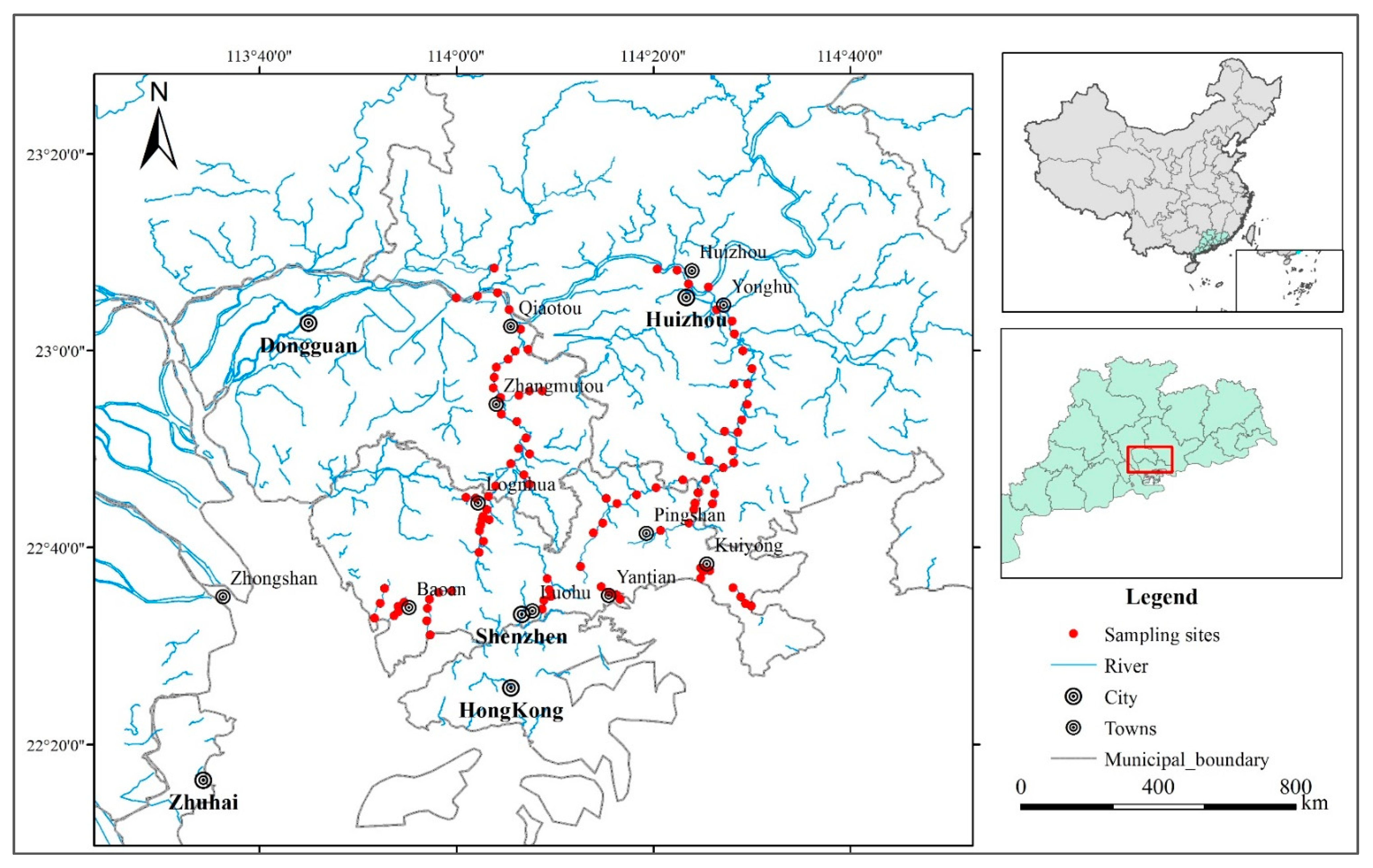
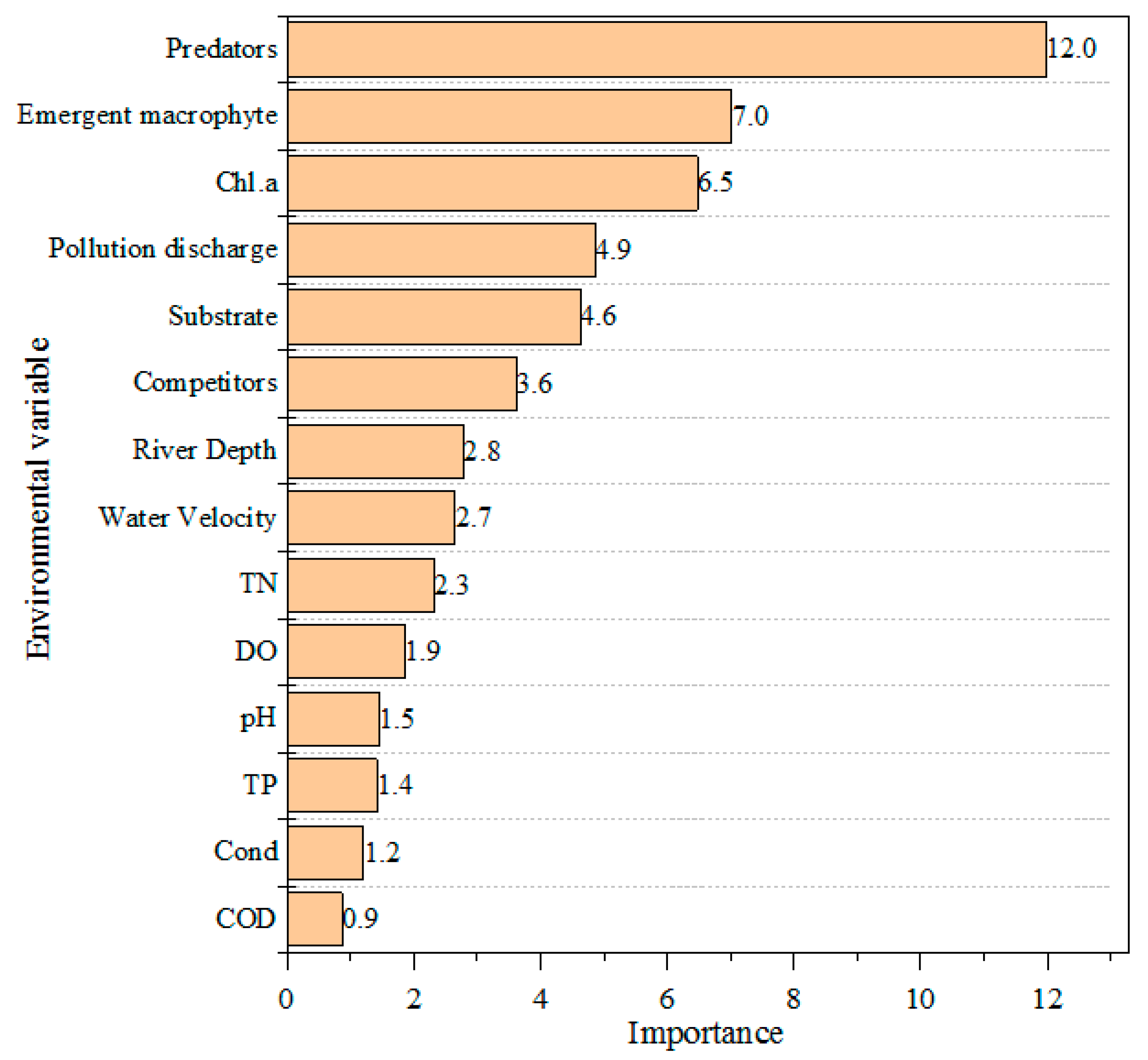
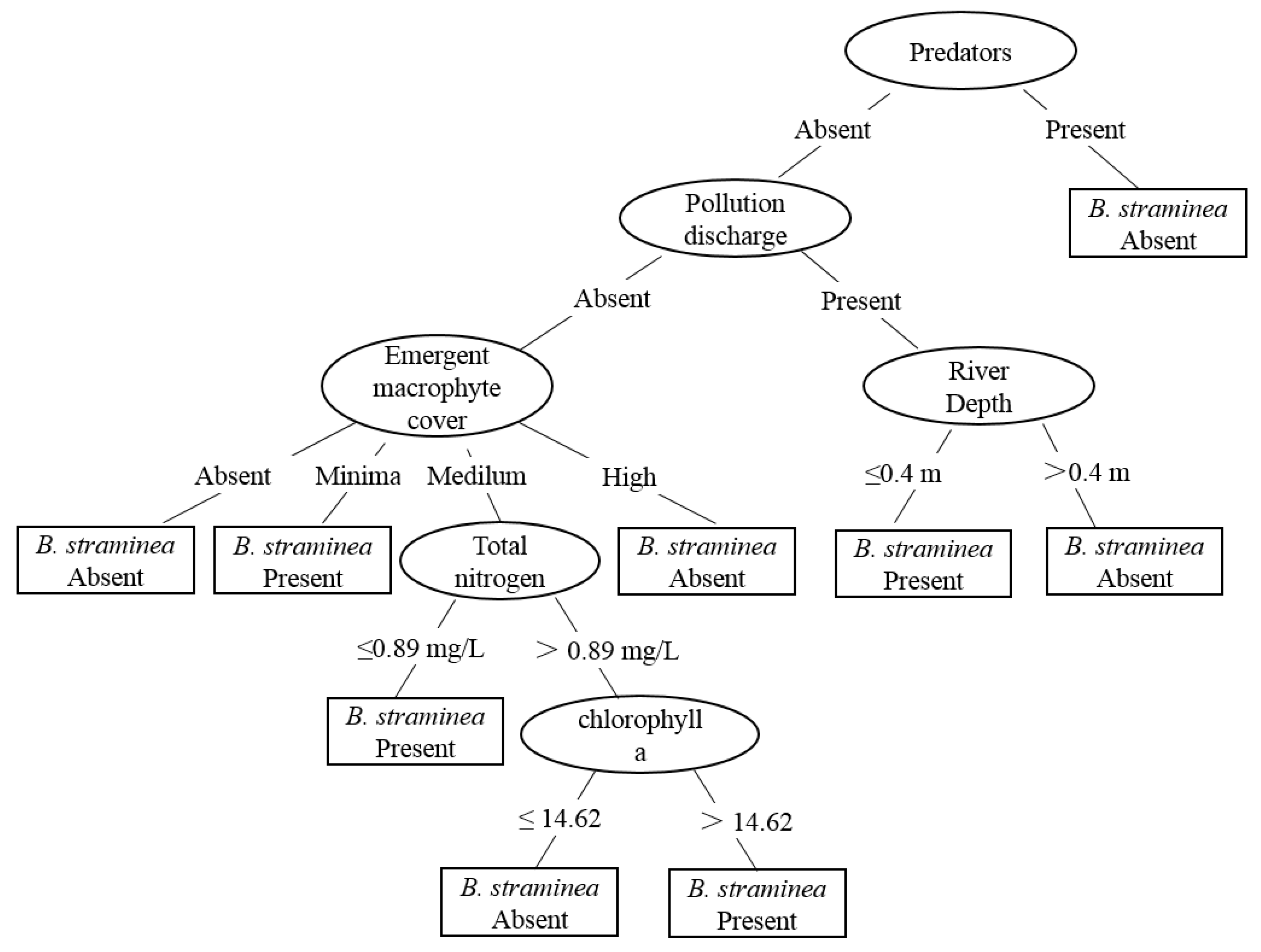
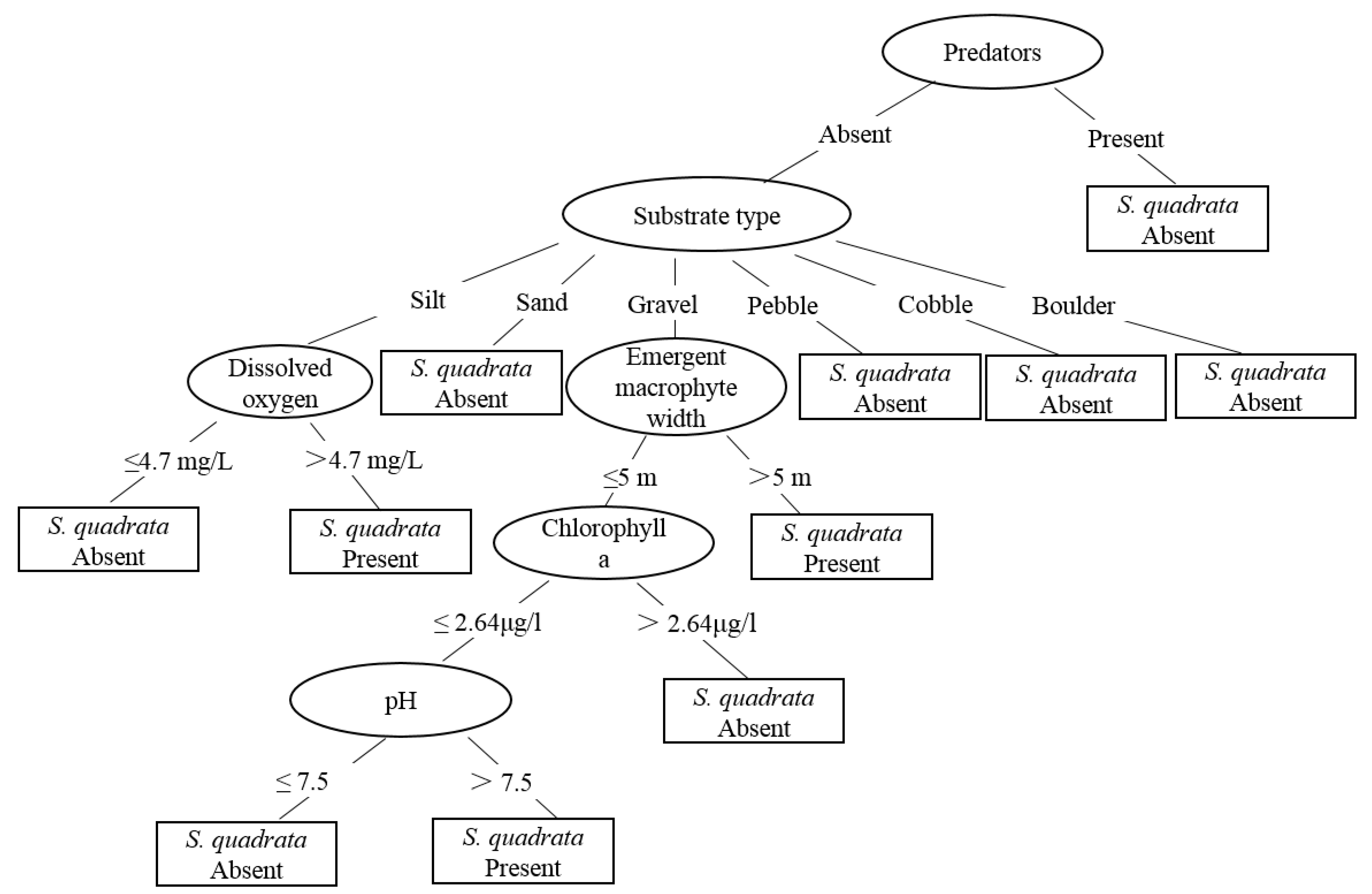
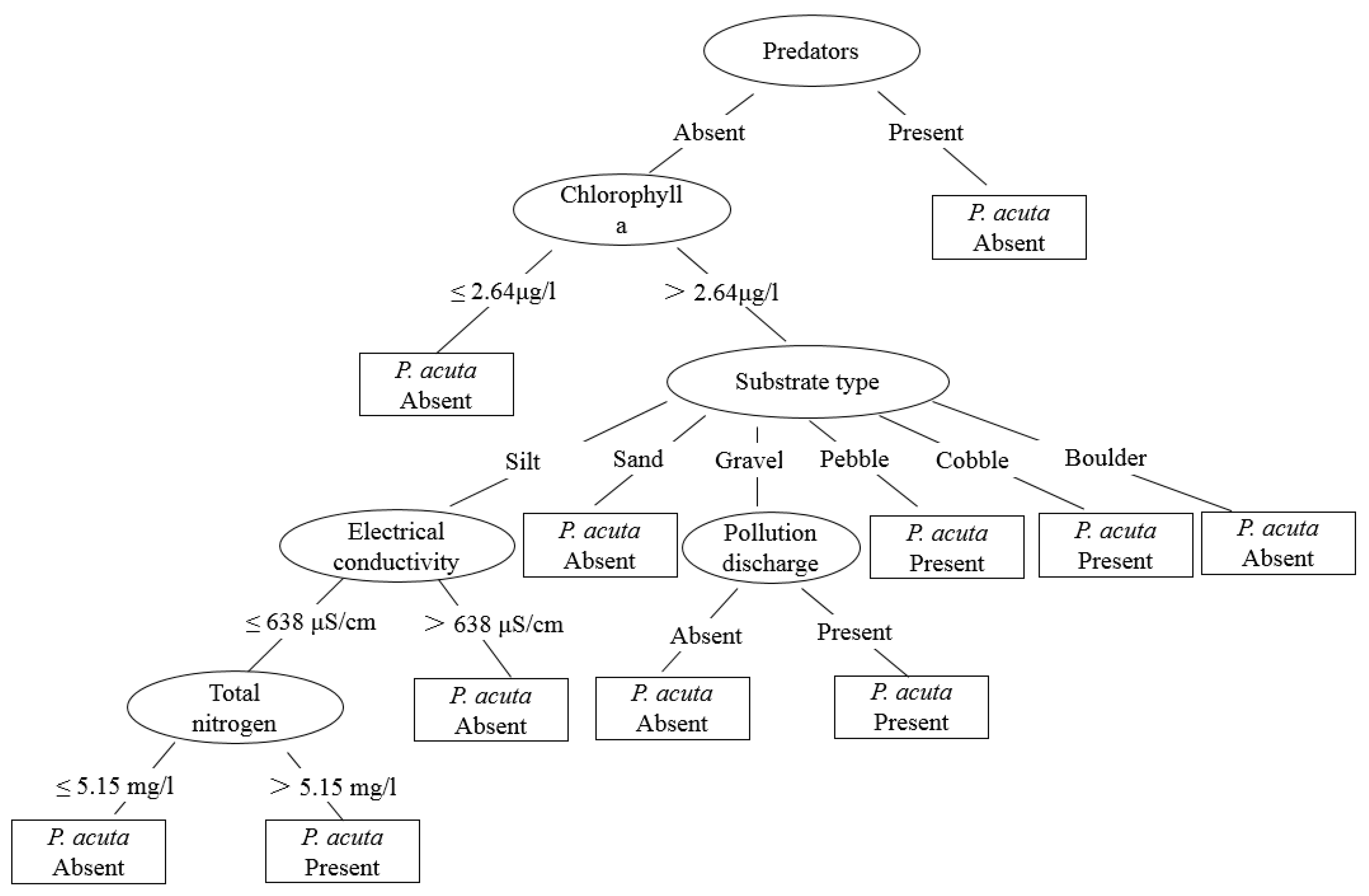
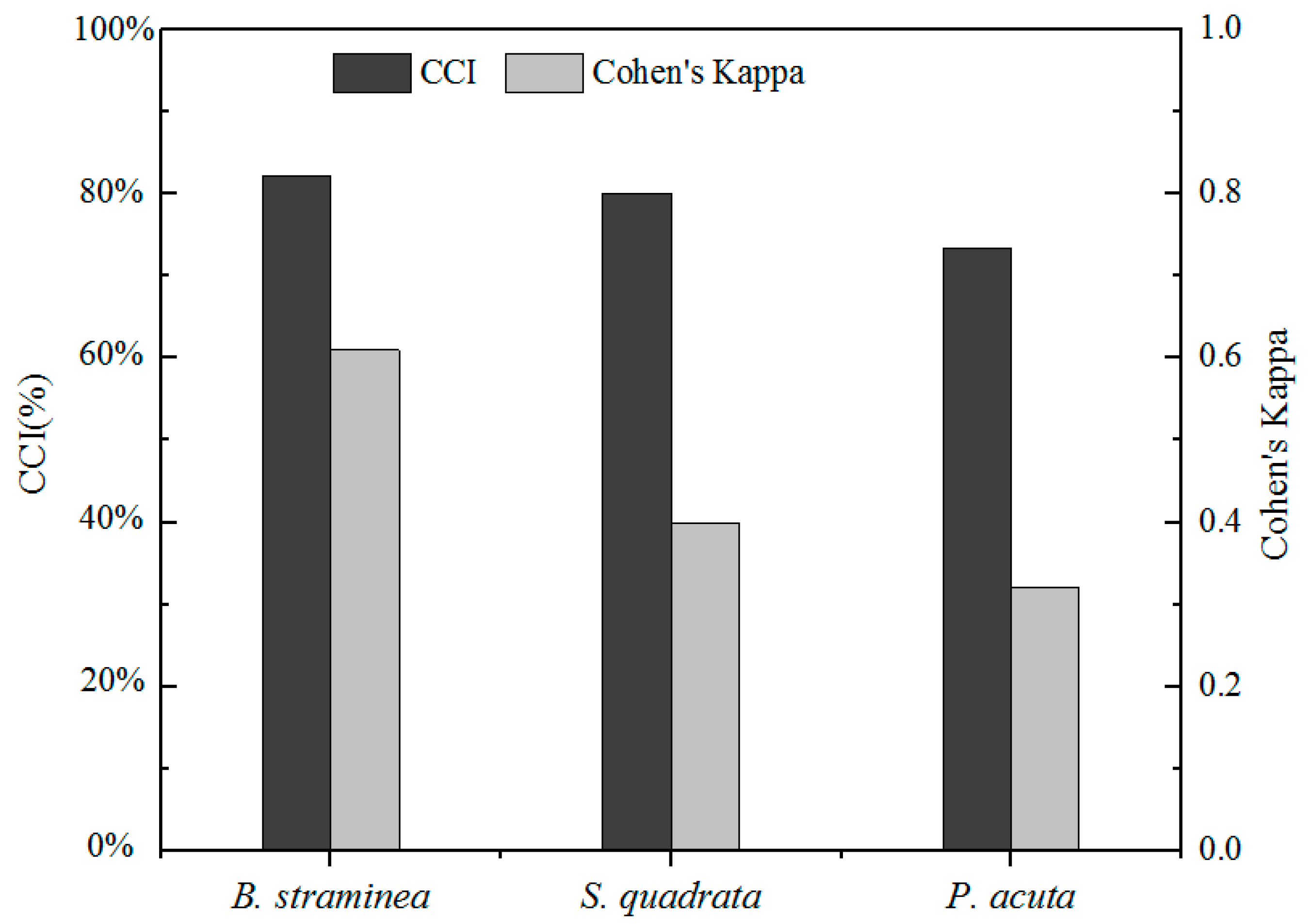

| Variable | Unit | Min. | Max. | Mean | SD |
|---|---|---|---|---|---|
| Water temperature | °C | 20.5 | 33 | 26.33 | 2.78 |
| River depth | Meter | 0.03 | 1.78 | 0.39 | 0.34 |
| Water velocity | m/s | 0 | 0.7 | 0.22 | 0.16 |
| River width | Meter | 3 | 620.0 | 63.03 | 121.90 |
| Dissolved oxygen | mg/L | 2.67 | 17.11 | 7.86 | 3.32 |
| pH | - | 6.4 | 8.56 | 7.48 | 0.39 |
| Total dissolved solids | mg/L | 60.45 | 4394.5 | 418.0 | 558.7 |
| Electrical conductivity | μS/cm | 6.8 | 6754 | 618.7 | 902.3 |
| Total nitrogen | mg/L | 0.64 | 27.5 | 9.75 | 6.65 |
| Nitrate and nitrites | mg/L | 0.1 | 23.6 | 4.49 | 4.45 |
| Ammoniacal nitrogen | mg/L | 0.02 | 14.89 | 3.72 | 4.05 |
| Total phosphorus | mg/L | 0.02 | 2.97 | 0.61 | 0.66 |
| Orthophosphate | mg/L | 0 | 1.9 | 0.36 | 0.47 |
| Chlorophyll-a | μg/L | 0.52 | 31.43 | 6.16 | 5.26 |
| Chemical oxygen demand | mg/L | 0.55 | 8.7 | 3.90 | 1.87 |
| Emergent macrophyte width | Meter | 0 | 30 | 3.26 | 5.40 |
| Floating macrophyte width | Meter | 0 | 100 | 2.36 | 11.79 |
| Emergent macrophyte cover | Very low(0), Low(1), Moderate(2), High(3) | NA | NA | NA | NA |
| Floating macrophyte cover | Very low(0), Low(1), Moderate(2), High(3) | NA | NA | NA | NA |
| Submerged macrophyte cover | Very low(0), Low(1), Moderate(2), High(3) | NA | NA | NA | NA |
| Substrate type | Silt(0), Sand(1), Gravel(2), Pebble(3), Cobble(4), Boulder(5) | NA | NA | NA | NA |
| Predator occurrence | Absent(0), Present(1) | NA | NA | NA | NA |
| Competitor occurrence | Absent(0), Present(1) | NA | NA | NA | NA |
| Predator abundance | Count | 0 | 504 | 15 | 57 |
| Competitor abundance | Count | 0 | 672 | 43 | 115 |
| Fishing | Absent(0), Minimal(1), Medium(2), High(3) | NA | NA | NA | NA |
| Shipping | Absent(0), Minimal(1), Medium(2), High(3) | NA | NA | NA | NA |
| Clothes washing | Absent(0), Minimal(1), Medium(2), High(3) | NA | NA | NA | NA |
| Dredging | Absent(0), Minimal(1), Medium(2), High(3) | NA | NA | NA | NA |
| Pollution discharge | Absent(0), Minimal(1), Medium(2), High(3) | NA | NA | NA | NA |
| Farming | Absent(0), Minimal(1), Medium(2), High(3) | NA | NA | NA | NA |
| Irrigation | Absent(0), Minimal(1), Medium(2), High(3) | NA | NA | NA | NA |
| Family | Genus | Species | Parasites | Reference |
|---|---|---|---|---|
| Viviparidae | Sinotaia | Sinotaia quadrata | A. cantonensis | [61] |
| Sinotaia limnophila | E. revolutum | [62] | ||
| Cipangopaludina | Cipangopaludina chinensis | A. cantonensis | [61] | |
| Physidae | Physella | Physella acuta | A. cantonensis | [61] |
| Lymnaeidae | Radix | Radix auricularia | A. cantonensis; F. hepatica | [63] |
| Planorbidae | Biomphalaria | Biomphalaria straminea | S. mansoni; A. cantonensis | [64,65] |
| Semisulcospiridae | Semisulcospira | Semisulcospira cancellata | A. cantonensis; C. sinensis; P. westermani | [66] |
| Semisulcospira libertina | Paragonimus westermani | [67] | ||
| Ampullariidae | Pomacea | Pomacea canaliculata | A. cantonensis; E. revolutum; G. spinigerum | [68,69,70] |
| Species | Number of Collected Snails | Percentage of Total Snail Number | Number of Sites | Frequency of Occurrence |
|---|---|---|---|---|
| Biomphalaria straminea | 2865 | 54.7% | 32 | 31.4% |
| Sinotaia quadrata | 679 | 13.0% | 26 | 25.5% |
| Physella acuta | 448 | 8.6% | 23 | 22.5% |
| Semisulcospira cancellata | 496 | 9.5% | 15 | 14.7% |
| Radix auricularia | 232 | 4.4% | 14 | 13.7% |
| Semisulcospira libertina | 409 | 7.8% | 12 | 11.8% |
| Pomacea canaliculata | 32 | 0.6% | 9 | 8.8% |
| Sinotaia limnophila | 29 | 0.6% | 7 | 6.9% |
| Cipangopaludina chinensis | 48 | 0.9% | 4 | 3.9% |
Publisher’s Note: MDPI stays neutral with regard to jurisdictional claims in published maps and institutional affiliations. |
© 2022 by the authors. Licensee MDPI, Basel, Switzerland. This article is an open access article distributed under the terms and conditions of the Creative Commons Attribution (CC BY) license (https://creativecommons.org/licenses/by/4.0/).
Share and Cite
Min, F.; Wang, J.; Liu, X.; Yuan, Y.; Guo, Y.; Zhu, K.; Chai, Z.; Zhang, Y.; Li, S. Environmental Factors Affecting Freshwater Snail Intermediate Hosts in Shenzhen and Adjacent Region, South China. Trop. Med. Infect. Dis. 2022, 7, 426. https://doi.org/10.3390/tropicalmed7120426
Min F, Wang J, Liu X, Yuan Y, Guo Y, Zhu K, Chai Z, Zhang Y, Li S. Environmental Factors Affecting Freshwater Snail Intermediate Hosts in Shenzhen and Adjacent Region, South China. Tropical Medicine and Infectious Disease. 2022; 7(12):426. https://doi.org/10.3390/tropicalmed7120426
Chicago/Turabian StyleMin, Fengyang, Jiasheng Wang, Xiaoguang Liu, Yi Yuan, Yunhai Guo, Kongxian Zhu, Zhaohui Chai, Yunchao Zhang, and Shizhu Li. 2022. "Environmental Factors Affecting Freshwater Snail Intermediate Hosts in Shenzhen and Adjacent Region, South China" Tropical Medicine and Infectious Disease 7, no. 12: 426. https://doi.org/10.3390/tropicalmed7120426
APA StyleMin, F., Wang, J., Liu, X., Yuan, Y., Guo, Y., Zhu, K., Chai, Z., Zhang, Y., & Li, S. (2022). Environmental Factors Affecting Freshwater Snail Intermediate Hosts in Shenzhen and Adjacent Region, South China. Tropical Medicine and Infectious Disease, 7(12), 426. https://doi.org/10.3390/tropicalmed7120426







